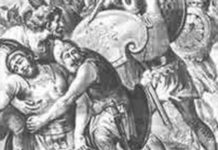The Heavy Armored gladiators have been grouped into eight categories. It should be understood that some types of gladiators were more popular than other at times – some categories actually vanished and were replaced by others – and that some similarities of equipment exist between them. In alphabetical order, the strongly armored gladiators were:
Cataphractarius
This type of gladiator wore burdensome scale armor from head to toe, but used no shield. The head was protected by a simple conical helmet that could include nasal and cheek defenses. The Cataphractarius weapon was a long, heavy lance called the contus. They fought against lightly armored but more agile opponents.
Gallus
As the name implies this gladiator represented a fighter from Gaul. The Gallus, dressed in a loin cloth, he wore armor: a smooth, visored, bell-shaped helmet, body armor and shin guard on his left leg. His right arm was protected by a leather manica and on his left he carried a large rectangular shield. A gladius (the short, about 27 inches, Roman sword) and or a lance were his weapons. The Gallus also fought lightly armored, nimble adversaries.
Hoplomachi
Greatly armored like a Greek Hoplite. He wore a large crested, brimmed helmet decorated with plumes or feathers, body armor as well as a metal guard on his left shin and leather manica to protect his right arm. A small shield, usually round, completed the Hoplomachi’s defenses. He was armed with a gladius, a six foot spear called the hasta and, on occasion, a dagger was added.
Murmillo
So named because of the mormy or murmo (a fish common in the Mediterranean Sea)crest atop their helmets. They wore no body armor, except on their right arm. A shin guard covered their left leg and they carried the large, square shield of the Roman legionnaire. Their weapon was the gladius. The Murmillo fought other armored gladiators. Replaced the Gallus.
Provocatore
The name means challenger, and that is about all that appears certain about this type of fighter. Some sources state that their armor was unknown; while others affirm they dressed and were armored like legionnaires. Still others consider that they were the only gladiators to wear a cardiophylax (breast plate) and that they wore two feathers on their helmets. Their antagonists could have been others of the greatly armored types, or just their own kind.
Sammite
The precursor of the Hoplomachi was an early type of armored gladiator. They however wore no body armor. The helmet and sword were similar to the Hoplomachi, but the Sammite used the legionnaire shield. The change became politically necessary when the Sammites, a people of the south, central Apennine Mountains, became Rome’s allies.
Scizore
So named because of the sword they used which looked like open scissors. Wore a loincloth of various colors, no body armor and his only protection was a manica of linen or leather and a shin guard on the left leg. His helmet was round and smooth with small openings for the eyes to protect him from his main opponent in the arena, the Retiarius or net man armed with a trident.
Secutor
Slasher or carver. They chased their opponents and wore armor similar to the Murmillos, except for the helmet. The Secutor helmet was smaller and much closer to the face. The helmet was so tightly fitted and such small openings that if the Secutor didn’t win his competition quickly, he could pass out due to breathing problems
Most gladiators did not protect their feet; they wore sandals or no shoes at all.








